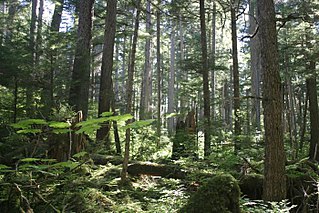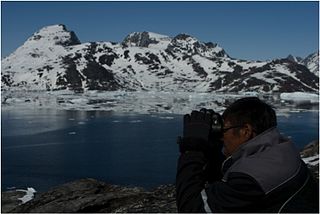Related Research Articles

Natural resources are resources that are drawn from nature and used with few modifications. This includes the sources of valued characteristics such as commercial and industrial use, aesthetic value, scientific interest, and cultural value. On Earth, it includes sunlight, atmosphere, water, land, all minerals along with all vegetation, and wildlife.
The conservation movement, also known as nature conservation, is a political, environmental, and social movement that seeks to manage and protect natural resources, including animal, fungus, and plant species as well as their habitat for the future. Conservationists are concerned with leaving the environment in a better state than the condition they found it in. Evidence-based conservation seeks to use high quality scientific evidence to make conservation efforts more effective.

Forestry is the science and craft of creating, managing, planting, using, conserving and repairing forests and woodlands for associated resources for human and environmental benefits. Forestry is practiced in plantations and natural stands. The science of forestry has elements that belong to the biological, physical, social, political and managerial sciences. Forest management plays an essential role in the creation and modification of habitats and affects ecosystem services provisioning.

Habitat conservation is a management practice that seeks to conserve, protect and restore habitats and prevent species extinction, fragmentation or reduction in range. It is a priority of many groups that cannot be easily characterized in terms of any one ideology.
Community-based economics or community economics is an economic system that encourages local substitution. It is similar to the lifeways of those practicing voluntary simplicity, including traditional Mennonite, Amish, and modern eco-village communities. It is also a subject in urban economics, related to moral purchasing and local purchasing.

Dame Alison Fettes Richard, is an English anthropologist, conservationist and university administrator. She was the 344th Vice-Chancellor of the University of Cambridge, the third Vice-Chancellor of Cambridge since the post became full-time, and the second woman. Before arriving at Cambridge, she served as the provost of Yale University from 1994 to 2002.
Adaptive management, also known as adaptive resource management or adaptive environmental assessment and management, is a structured, iterative process of robust decision making in the face of uncertainty, with an aim to reducing uncertainty over time via system monitoring. In this way, decision making simultaneously meets one or more resource management objectives and, either passively or actively, accrues information needed to improve future management. Adaptive management is a tool which should be used not only to change a system, but also to learn about the system. Because adaptive management is based on a learning process, it improves long-run management outcomes. The challenge in using the adaptive management approach lies in finding the correct balance between gaining knowledge to improve management in the future and achieving the best short-term outcome based on current knowledge. This approach has more recently been employed in implementing international development programs.

Natural resource management (NRM) is the management of natural resources such as land, water, soil, plants and animals, with a particular focus on how management affects the quality of life for both present and future generations (stewardship).
Integrated conservation and development projects (ICDPs), are biodiversity conservation projects with rural development components. It is an approach that aspires to combine social development with conservation goals. These projects look to deal with biodiversity conservation objectives through the use of socio-economic investment tools. The World Wide Fund for Nature (WWF), first introduced ICDPs in the mid-1980s. They wanted to attend to some of the problems associated with the “fines and fences” (non-participatory) approach to conservation.

Ecosystem management is an approach to natural resource management that aims to ensure the long-term sustainability and persistence of an ecosystem's function and services while meeting socioeconomic, political, and cultural needs. Although indigenous communities have employed sustainable ecosystem management approaches implicitly for millennia, ecosystem management emerged explicitly as a formal concept in the 1990s from a growing appreciation of the complexity of ecosystems and of humans' reliance and influence on natural systems.
Nat Quansah is a botanist from Ghana.
Population, health, and the environment (PHE) is an approach to human development that integrates family planning and health with conservation efforts to seek synergistic successes for greater conservation and human welfare outcomes than single sector approaches. There is a deep relationship between population, health and environment. Those subjects are not only related to each other but also to other important aspects that are very necessary for keeping PHE in a close-knit relationship.
Blue Ventures is a registered charity focused on nurturing locally led marine conservation. The organisation partners with coastal communities that depend on marine resources.

Forest restoration is defined as "actions to re-instate ecological processes, which accelerate recovery of forest structure, ecological functioning and biodiversity levels towards those typical of climax forest", i.e. the end-stage of natural forest succession. Climax forests are relatively stable ecosystems that have developed the maximum biomass, structural complexity and species diversity that are possible within the limits imposed by climate and soil and without continued disturbance from humans. Climax forest is therefore the target ecosystem, which defines the ultimate aim of forest restoration. Since climate is a major factor that determines climax forest composition, global climate change may result in changing restoration aims. Additionally, the potential impacts of climate change on restoration goals must be taken into account, as changes in temperature and precipitation patterns may alter the composition and distribution of climax forests.

Pavan Sukhdev is an Indian environmental economist whose field of studies include green economy and international finance. He was the Special Adviser and Head of UNEP's Green Economy Initiative, a major UN project suite to demonstrate that greening of economies is not a burden on growth but rather a new engine for growing wealth, increasing decent employment, and reducing persistent poverty. Pavan was also the Study Leader for the ground breaking TEEB study commissioned by G8+5 and hosted by UNEP. Under his leadership, TEEB sized the global problem of biodiversity loss and ecosystem degradation in economic and human welfare terms, and proposed solutions targeted at policy-makers, administrators, businesses and citizens. TEEB presented its widely acclaimed Final Report suite at the UN meeting by Convention on Biological Diversity (CBD) in Nagoya, Japan.

Distinguished Professor David Lindenmayer,, is an Australian scientist and academic. His research focuses on the adoption of nature conservation practices in agricultural production areas, developing ways to improve integration of native forest harvesting and biodiversity conservation, new approaches to enhance biodiversity conservation in plantations, and improved fire management practices in Australia. He specialises in large-scale, long-term research monitoring programs in south-eastern Australia, primarily in forests, reserves, national parks, plantations, and on farm land.

Participatory monitoring is the regular collection of measurements or other kinds of data (monitoring), usually of natural resources and biodiversity, undertaken by local residents of the monitored area, who rely on local natural resources and thus have more local knowledge of those resources. Those involved usually live in communities with considerable social cohesion, where they regularly cooperate on shared projects.

Ravindra Kumar Sinha is a Padma Shri awarded Indian biologist and environmentalist. He served as Vice-Chancellor of Shri Mata Vaishno Devi University from 2019-2023 and also served in Nalanda Open University. Previously he was the Head of the Department of Zoology at Patna University, and is a pioneer researcher and wildlife conservationist, famous for his efforts for the conservation of Gangetic Dolphins, he is popularly known as the "Dolphin Man of India".
Jamuna Sharan Singh is an Indian ecologist, academic and a former professor of botany and ecological sciences at Banaras Hindu University. He is known for his studies on the grassland ecosystems which are reported to have assisted in the better management of tropical grasslands. He is an elected fellow of the Indian National Science Academy, Indian Academy of Sciences, The World Academy of Sciences and the National Academy of Sciences, India. The Council of Scientific and Industrial Research, the apex agency of the Government of India for scientific research, awarded him the Shanti Swarup Bhatnagar Prize for Science and Technology, one of the highest Indian science awards, in 1980, for his contributions to biological sciences.
Anitry Ny Aina Ratsifandrihamanana (Nanie) is a Malagasy conservationist and is the country director of WWF Madagascar and western Indian Ocean Islands.
References
- 1 2 3 4 5 "Jeanneney Rabearivony: un gestionnaire de l'environnement". wwf.panda.org. Retrieved 2020-06-26.
- ↑ Falcon Productions (2017-11-02), Madagascar | Life On The Edge , retrieved 2020-06-26
- 1 2 "Jeanneney Rabearivony | Beahrs Environmental Leadership Program" . Retrieved 2020-06-25.
- ↑ Rabearivony, Jeanneney; Thorstrom, Russell; de Roland, Arison; Rakotondratsima, Marius; Andriamalala, Tolojanahary R.A.; Sam, The Seing; Razafimanjato, Gilbert; Rakotondravony, Daniel; Raselimanana, Achille P.; Rakotoson, Michel. "Protected area surface extension in Madagascar: Do endemism and threatened species remain useful criteria for site selection ?" (PDF). Madagascar Conservation & Development. 5: 35–47.
- ↑ "FAMPAHAFANTARANA : " FIHARIANA : HIANTOKA FAMATSIAMBOLA 2 hetsy ariary ka hatramin'ny 200 tapitrisa ariary"" (PDF).